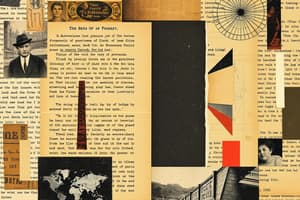Podcast
Questions and Answers
What are historical sources used for?
What are historical sources used for?
- Writing of history (correct)
- Entertainment
- Cooking
- Sports
Which of the following is a type of primary source?
Which of the following is a type of primary source?
- Articles analyzing historical events
- Textbooks
- Documentaries
- Eyewitness accounts (correct)
A handwritten or typed record that has not been printed is known as a ______.
A handwritten or typed record that has not been printed is known as a ______.
manuscript
What is external criticism in historical research?
What is external criticism in historical research?
What are sociofacts?
What are sociofacts?
Match the following types of sources to their definitions:
Match the following types of sources to their definitions:
All historical sources are written documents.
All historical sources are written documents.
What is the importance of the historical method?
What is the importance of the historical method?
Flashcards are hidden until you start studying
Study Notes
Historical Sources
- Historical sources are materials utilized for writing history and include various classifications.
Types of Historical Sources
- Published Materials: Available to the public, including books, magazines, journals, travelogues, and speech transcripts.
- Manuscripts: Handwritten or typed records that are unpublished, encompassing archives, memoirs, and diaries.
- Non-Written Sources: Oral history, artifacts, ruins, fossils, artworks, and audio/video recordings that provide insight into past events.
Primary Sources
- Involve individuals or groups directly associated with an event, either as participants or eyewitnesses.
- Include diaries, letters, legal documents, and photographs that offer firsthand accounts.
Categories of Sources
- Written Sources: Documents created by firsthand eyewitnesses.
- Images: Visual representations made or published by those who witnessed the events.
- Artifacts: Physical items created by firsthand eyewitnesses.
- Oral Testimonies: Conversations documented by firsthand witnesses.
Secondary Sources
- Analyze and interpret primary sources, often containing pictures, quotes, or graphics related to the primary data.
External Criticism
- Tests to assess the authenticity of historical documents.
- Anachronistic Document Date: Evaluates if the document's date fits within its intended timeframe.
- Author Identification: Establishes the true author through handwriting and signatures.
- Anachronistic Style: Examines idiomatic expressions and orthography for chronological accuracy.
- Anachronistic Event Reference: Determines if references to events are temporally appropriate.
- Provenance or Custody: Investigates the document's history and ownership to ascertain authenticity.
- Semantics: Analyzes text for meaning, ensuring clarity and accuracy.
- Hermeneutics: Focuses on understanding ambiguities in the text.
Internal Criticism
- Evaluates the credibility of eyewitness reports and accounts.
- Author’s Identification: Assesses the author's reliability based on their experiences and biases.
- Date Approximation: Ensures the event's date aligns closely with historical verification.
- Ability to Tell the Truth: Investigates the nearness and competence of witnesses to establish credible facts.
- Willingness to Tell the Truth: Evaluates the author's intent in conveying truthful narratives.
- Corroboration: Checks if information supports or confirms established historical facts.
Artifacts, Sociofacts, and Mentifacts
- Artifacts: Objects produced by humans reflecting specific cultural contexts.
- Sociofacts: Information or traditions linked to a cultural artifact; how societies are organized.
- Mentifacts: Ideas, beliefs, and values associated with artifacts; they reflect societal attitudes.
Historical Method
- A systematic approach to examining past events, leveraging historical criticism to evaluate sources.
- Recognizes the surrounding context of a passage, which may enhance its interpretive meaning.
Importance of Historical Study
- Aids in solving contemporary problems by providing insights drawn from past experiences and contexts.
Studying That Suits You
Use AI to generate personalized quizzes and flashcards to suit your learning preferences.



